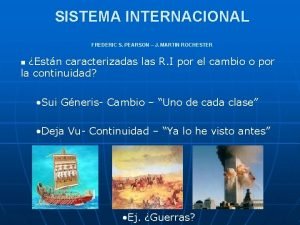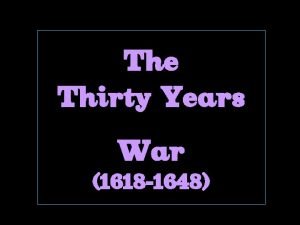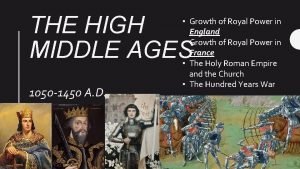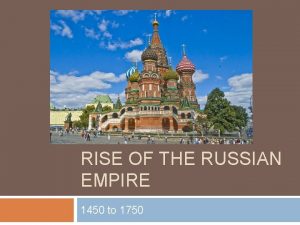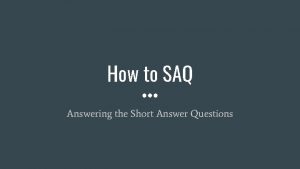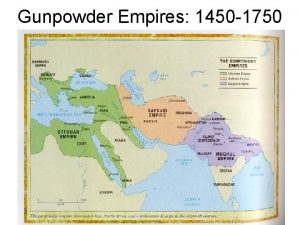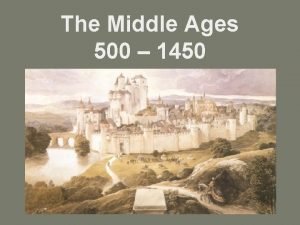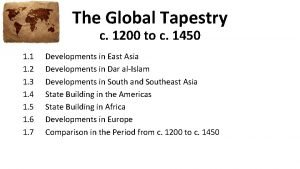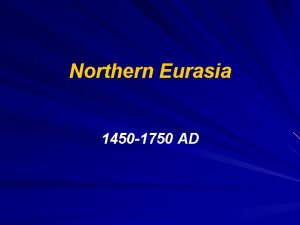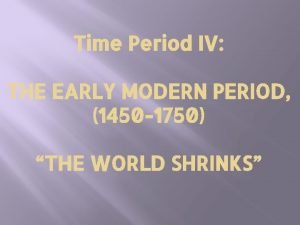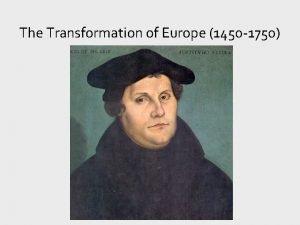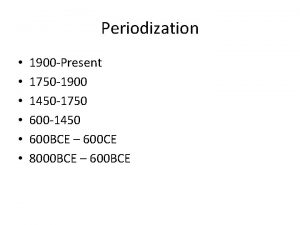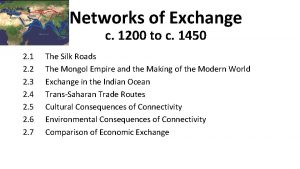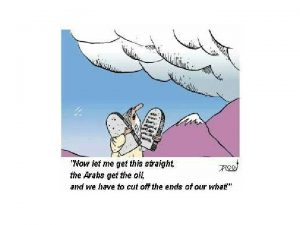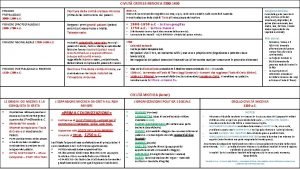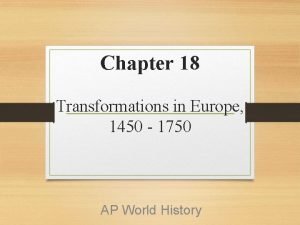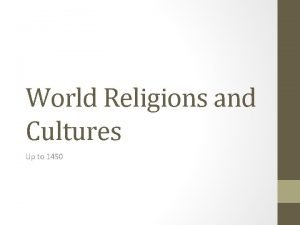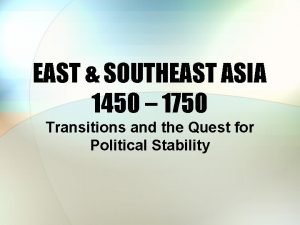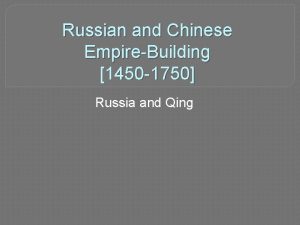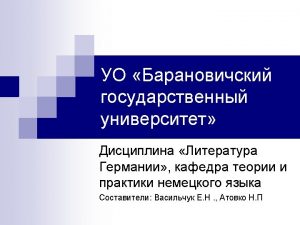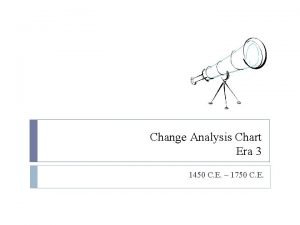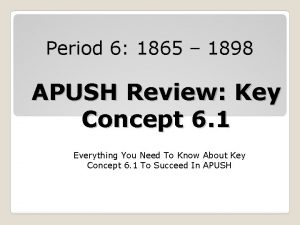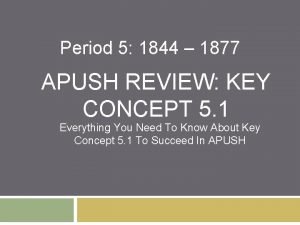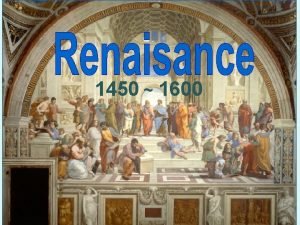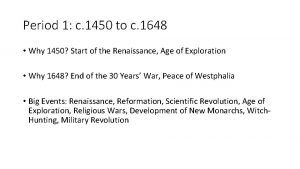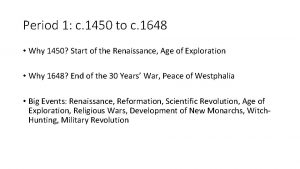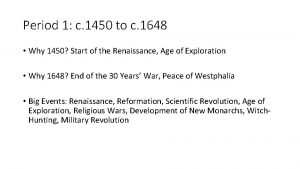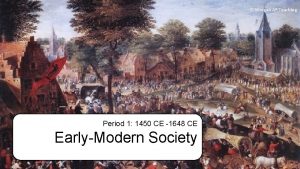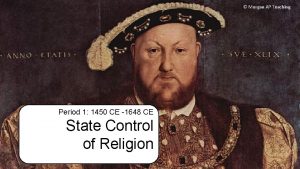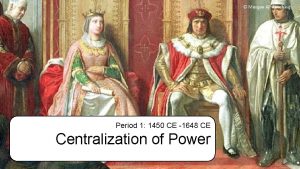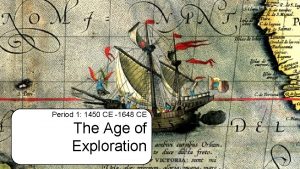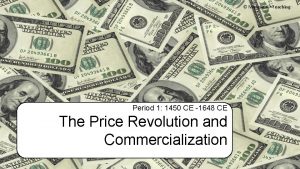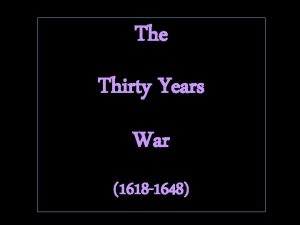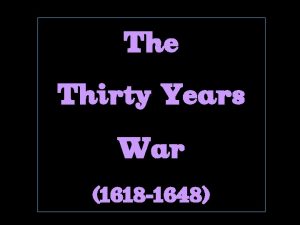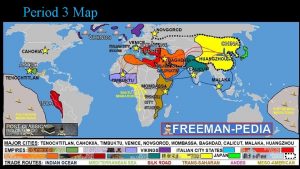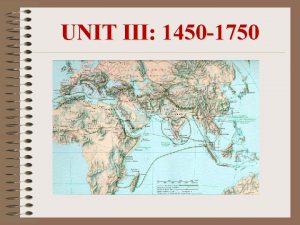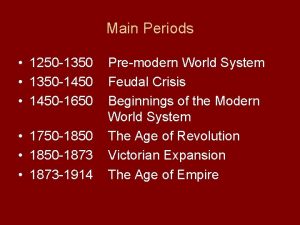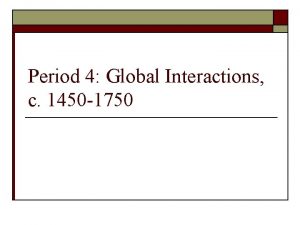Period 1 c 1450 to c 1648 KEY











































- Slides: 43

Period 1: c. 1450 to c. 1648 KEY CONCEPT 1. 5 European society and the experiences of everyday life were increasingly shaped by commercial and agricultural capitalism, notwithstanding the persistence of medieval social and Working the Land 554 -558 economic structures. The Return of Serfdom in the East 482 Social Unrest in a Changing Society 358 -365 17 th Century Crisis and Rebuilding 480 -486 Building the Global Economy 569 -581 Marriage and the Family 586 -591 Peasant Life in the Midst of Economic Crisis 480 -481 Social Hierarchies 393 -397 Early Reformation 408 -419 Popular Culture and Consumerism 595 -605 Religious Violence 433 -437

KEY CONCEPT 1. 5 In the 16 th and 17 th centuries, Europeans experienced profound economic and social changes. The influx of precious metals from the Americas and the gradual recovery of Europe’s population from the Black Death caused a significant rise in the cost of goods and services by the 16 th century, known as the price revolution. The new pattern of economic enterprise and investment that arose from these changes would come to be called capitalism. Family-based banking houses were supplanted by broadly integrated capital markets in Genoa, then in Amsterdam, and later in London. These and other urban centers became increasingly active consumer markets for a variety of luxury goods and commodities. Rulers soon recognized that capitalist enterprise offered them a revenue source to support state functions, and the competition among states was extended into the economic arena. The drive for economic profit and the increasing scale of commerce stimulated the creation of joint-stock companies to conduct overseas trade and colonization. Many Europeans found their daily lives altered by these demographic and economic changes. As population increased in the 16 th century, the price of grain rose and diets deteriorated, all as monarchs were increasing taxes to support their larger state militaries. All but the wealthy were vulnerable to food shortages, and even the wealthy had no immunity to recurrent lethal epidemics. Although hierarchy and privilege continued to define the social structure, the nobility and gentry expanded with the infusion of new blood from the commercial and professional classes. By the mid-17 th century, war, economic contraction, and slackening population growth contributed to the disintegration of older communal values. Growing numbers of the poor became beggars or vagabonds, straining the traditional systems of charity and social control. In eastern Europe, commercial development lagged and traditional social patterns persisted; the nobility actually increased its power over the peasantry. Traditional town governments, dominated by craft guilds and traditional religious institutions, staggered under the burden of rural migrants and growing poverty. The Reformation and Counter-Reformation stimulated a drive to regulate public morals, leisure activities, and the distribution of poor relief. In both town and country, the family remained the dominant unit of production, and marriage remained an instrument of families’ social and economic strategies. The children of peasants and craft workers often labored alongside their parents. In the lower orders of society, men and women did not occupy separate spheres, although they performed different tasks. Economics often dictated later marriages (European marriage pattern). However, there were exceptions to this pattern: In the cities of Renaissance Italy, men in their early 30 s often married teenaged women, and in eastern Europe, early marriage for both men and women persisted. Despite the growth of the market economy in which individuals increasingly made their own way, leisure activities tended to be communal, rather than individualistic and consumerist, as they are today. Local communities enforced their customs and norms through crowd action and rituals of public shaming.

Working the Land 554 -558 I. Most Europeans derived their livelihood from agriculture and oriented their lives around the seasons, the village, or the manor, although economic changes began to alter rural production and power. [PP-2 | PP-9 | IS-1 | IS-2]

Working the Land 554 -558 1. 5. II IS-1 Explain the characteristics of subsistence agriculture in traditional communities in preindustrial Europe. 1. 5. II PP-2 How did the commercialization of agriculture impact economic growth and the standard of living in preindustrial Europe. 1. 5. II PP-9 Assess how peasants across Europe were affected by and responded to the commercialization of agriculture, abolition of traditional rights, policies of landlords, increased taxation, and the price revolution in the early modern period. 1. 5. II IS-2 Explain how the price revolution and commercial agriculture challenged the dominance of corporate groups and traditional estates. 1. 5. II PP-2 How did the codification of serfdom influence the standard of living in Eastern Europe.

Working the Land 554 -558 A. Subsistence agriculture was the rule in most areas, with three-crop field rotation in the north and two-crop rotation in the Mediterranean; in many cases, farmers paid rent and labor services for their lands.

Working the Land 554 -558 Describe the lifestyle of 80+% of Europe.

Working the Land 554 -558 w Enclosure movement B. The price revolution contributed to the accumulation of capital and the expansion of the market economy through the commercialization of agriculture, which benefited large landowners in western Europe.

Working the Land 554 -558 w Restricted use of the village common

Working the Land 554 -558 w Free-hold tenure

The Return of Serfdom in the East 482 C. As western Europe moved toward a free peasantry and commercial agriculture, serfdom was codified in the east, where nobles continued to dominate economic life on large estates.

Social Unrest in a Changing Society 358 -365 D. The attempts of landlords to increase their revenues by restricting or abolishing the traditional rights of peasants led to revolt.


Social Unrest in a Changing Society 358 -365 II. Population shifts and growing commerce caused the expansion of cities, which often found their traditional political and social structures stressed by the growth. [PP-6 | PP-13 | IS-2 | IS-10]

Social Unrest in a Changing Society 358 -365 1. 5. III IS-2 Explain how urban expansion and its problems challenged the dominance of corporate groups and traditional estates. 1. 5. III PP-6 Analyze how the expansion of cities led to challenges to traditional political and social structures. 1. 5. III PP-13 Analyze how cities and states have attempted to address the problems brought about by economic modernization through government regulation of public morals. 1. 5. III IS-10 Analyze how and why Europeans marginalized urban migrants through the regulation of morals.

Social Unrest in a Changing Society 358 -365 A. Population recovered to its pre–Great Plague level in the 16 th century, and continuing population pressures contributed to uneven price increases; agricultural commodities increased more sharply than wages, reducing living standards for some.

Social Unrest in a Changing Society 358 -365 B. Migrants to the cities challenged the ability of merchant elites and craft guilds to govern and strained resources. w w Sanitation problems caused by overpopulation Employment Poverty Crime

Social Unrest in a Changing Society 358 -365 C. Social dislocation, coupled with the weakening of religious institutions during the Reformation, left city governments with the task of regulating public morals. w w Stricter codes on prostitution and begging Abolishing or restricting Carnival


17 th Century Crisis and Rebuilding 480 -486 1. 5. I IS-2 Explain how the growth of financial and commercial innovations challenged the dominance of traditional estates. 1. 5. I IS-7 Evaluate how the new economic elites and hierarchy have defined the individual in relationship to society.

17 th Century Crisis and Rebuilding 480 -486 D. The growth of commerce produced a new economic elite, which related to traditional elites in different ways in Europe’s various geographic regions. w Gentry in England w w Nobles of the robe in France Town elites (bankers and merchants) w Caballeros and hidalgos in Spain

Building the Global Economy 569 -581 III. Economic change produced new social patterns, while traditions of hierarchy and status persisted. [INT-11 | PP-6 | IS-1 | IS-2 | IS-7]

Building the Global Economy 578 -581 1. 5. I INT-11 Explain how the European money economy brought non-European societies into a global economic network. 1. 5. I PP-6 Analyze how expanding commerce led to new social patterns. 1. 5. I IS-1 Explain the belief in hierarchy and social status in traditional communities in preindustrial Europe.

Building the Global Economy 569 -581 A. Innovations in banking and finance promoted the growth of urban financial centers and a money economy. w w Double-entry bookkeeping Bank of Amsterdam w The Dutch East India Company w The British East India Company

Building the Global Economy 569 -581 B. Hierarchy and status continued to define social power and perceptions in rural and urban settings.


Marriage and the Family 586 -591 I. The family remained the primary social and economic institution of early modern Europe and took several forms, including the nuclear family. [PP-7 | OS-4 | IS-1 | IS-4 | IS-6 | IS-9]

Marriage and the Family 586 -591 1. 5. IV PP-7 Explain how the family was the primary social and economic institution in pre-industrial Europe. 1. 5. IV IS-6 Evaluate the women’s role in the family economy. 1. 5. IV IS-4 Analyze how and why family, gender roles, and marriage patterns has changed over time.

Marriage and the Family 586 -591 A. Rural and urban households worked as units, with men and women engaged in separate but complementary tasks.

Peasant Life in the Midst of Economic Crisis 480 -481 B. From the late 16 th century forward, Europeans responded to economic and environmental challenges, such as the “Little Ice Age, ” by delaying marriage and childbearing, which restrained population growth and ultimately improved the economic condition of families.

Social Hierarchies 393 -397 1. 5. IV IS-6 Evaluate Renaissance debates on women’s role and status in the private versus the public sphere. 1. 5. IV IS-9 Assess the extent to which women participated in and benefited from the Renaissance.

Social Hierarchies 393 -397 B. The Renaissance movement raised debates about female roles in the family, society, and the church.

Social Hierarchies 393 -397 w Women’s intellect and education

Early Reformation 408 -419 1. 5. IV OS-4 Explain how Renaissance and Reformation challenged and preserved social order and roles, especially the roles of women. 1. 5. IV IS-1 Explain the family economy, gender roles and European marriage pattern in preindustrial Europe and how they were challenged by religious reform. 1. 5. IV IS-9 Assess the extent to which women participated in and benefited from the Reformation.

Early Reformation 408 -419 E. The Reformation raised debates about female roles in the family, society, and the church. Katharina von Bora w La Querelle des Femmes w Women as preachers


Popular Culture and Consumerism 595 -605 V. Popular culture, leisure activities, and rituals reflecting the persistence of folk ideas reinforced and sometimes challenged communal ties and norms. [OS-1 | IS-6 | IS-10]

Popular Culture and Consumerism 595 -605 1. 5. V IS-1 Explain the characteristics, practices, and beliefs of folk culture and communal norms in traditional communities in preindustrial Europe and how they were influenced by religion. 1. 5. V IS-6 Evaluate communal norms and enforcement as a cause of persistent tensions between women’s role and status in the private versus the public sphere. 1. 5. V OS-1 Account for the persistence of traditional and folk understandings of the cosmos and causation in popular culture, even with the advent of the Scientific Revolution. 1. 5. V IS-10 Analyze how and why European communal norms have marginalized certain populations (defined as “other”) through the persecution of witchcraft.

Popular Culture and Consumerism 595 -605 A. Leisure activities continued to be organized according to the religious calendar and the agricultural cycle and remained communal in nature.

Popular Culture and Consumerism 595 -605 w Carnival w w Saint’s day festivities Blood sports

Popular Culture and Consumerism 595 -605 B. Local and church authorities continued to enforce communal norms through rituals of public humiliation. w w w Charivari Stocks Public whipping and branding

Popular Culture and Consumerism 595 -605 C. Reflecting folk ideas and social and economic upheaval, accusations of witchcraft peaked between 1580 and 1650.

Religious Violence 433 -437 What persistent old beliefs were still present?

Religious Violence 433 -437 What are the explanations for the insanity of the Great European Witch Hunt?
 Branches of catholic church
Branches of catholic church Sistema clasico internacional 1648 a 1789
Sistema clasico internacional 1648 a 1789 1618-1648
1618-1648 Key activity adalah
Key activity adalah Contoh bisnis model canvas makanan pdf
Contoh bisnis model canvas makanan pdf Mughal empire 1450 to 1750
Mughal empire 1450 to 1750 1450 ad
1450 ad Best buy st george utah
Best buy st george utah Fur trade 1450 to 1750
Fur trade 1450 to 1750 Russian empire art and architecture 1450 to 1750
Russian empire art and architecture 1450 to 1750 Saq examples
Saq examples Land based empires 1450 to 1750
Land based empires 1450 to 1750 Period 3 ap world history
Period 3 ap world history 500/1450
500/1450 Global tapestry definition
Global tapestry definition Japan 1450-1750
Japan 1450-1750 World map 1450
World map 1450 Europe 1450
Europe 1450 1750-600
1750-600 Adopalen
Adopalen 1250 bc
1250 bc 2300-1450
2300-1450 Europe 1450
Europe 1450 Agean art
Agean art Religion 1450-1750
Religion 1450-1750 Southeast asia 1450 to 1750
Southeast asia 1450 to 1750 Russian empire 1450-1750
Russian empire 1450-1750 Renaissance 1450 to 1600
Renaissance 1450 to 1600 1900-1450
1900-1450 Change analysis chart 1450 to 1750
Change analysis chart 1450 to 1750 Critical period vs sensitive period
Critical period vs sensitive period A&p flix activity: propagation of an action potential
A&p flix activity: propagation of an action potential Is hyperpolarization the same as refractory period
Is hyperpolarization the same as refractory period Critical period vs sensitive period
Critical period vs sensitive period Critical period
Critical period Approaches to child development
Approaches to child development Less complicated texture than baroque (more homophonic)
Less complicated texture than baroque (more homophonic) Metallic, period 4, 20 electrons
Metallic, period 4, 20 electrons What served as the seed of activism?
What served as the seed of activism? Stability period vs measurement period
Stability period vs measurement period Trustee period and royal period
Trustee period and royal period Difference between historic period and prehistoric period
Difference between historic period and prehistoric period Period 6 key concepts
Period 6 key concepts Apush period 5 key concepts
Apush period 5 key concepts

